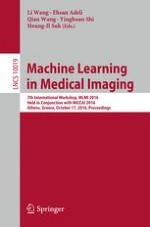2016 | Book
Machine Learning in Medical Imaging
7th International Workshop, MLMI 2016, Held in Conjunction with MICCAI 2016, Athens, Greece, October 17, 2016, Proceedings
Editors: Li Wang, Ehsan Adeli, Qian Wang, Yinghuan Shi, Heung-Il Suk
Publisher: Springer International Publishing
Book Series : Lecture Notes in Computer Science
